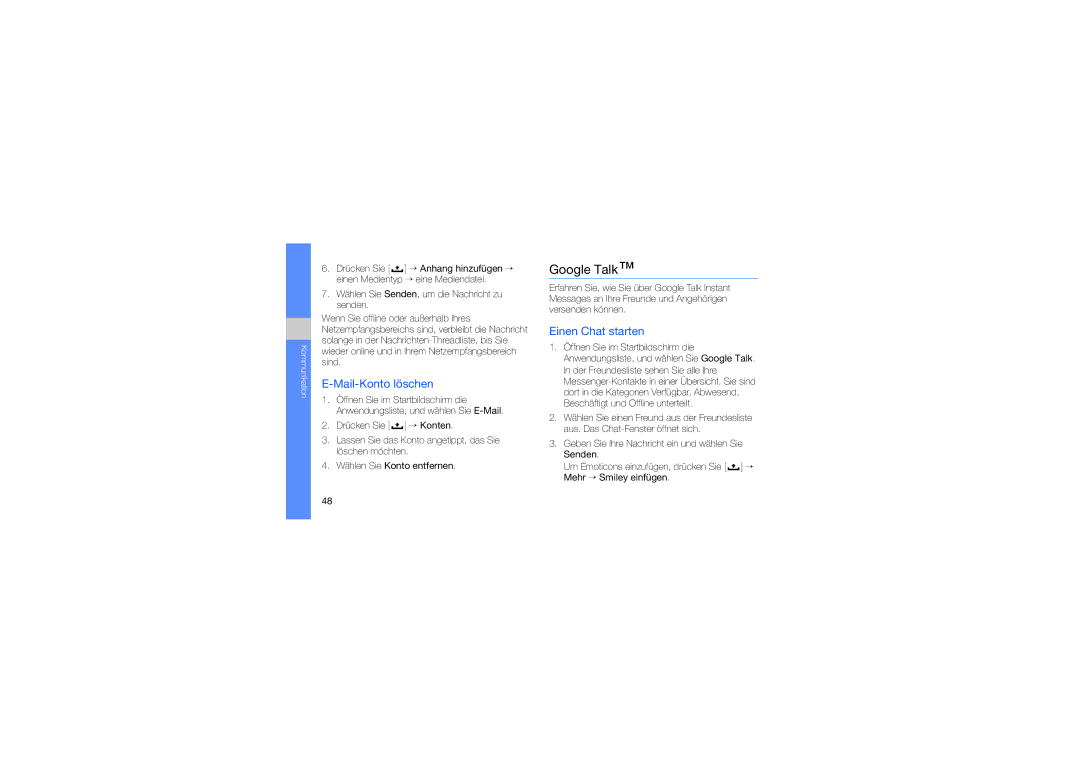Benutzerhandbuch
Anweisungssymbole
Dieses Handbuch verwenden
Urheberrechtsinformationen
Inhalt
Mobilgerät zusammenbauen und
Machen Sie sich mit dem
Anwendungen herunterladen von
Herunterladen von Dateien aus dem
Rat und Hilfe bei Problemen
Sicherheitswarnungen
Halten Sie Kleinkinder und Haustiere vom Gerät fern
Schützen Sie Ihr Gehör
Installieren Sie Mobilgeräte und Ausrüstung mit Sorgfalt
Vermeiden Sie Störungen bei Herzschrittmachern
Explosionsgefährdete Bereiche
Sicherheitshinweise
Sicherheit im Straßenverkehr steht an erster Stelle
Hörgeräte
Besondere Einrichtungen
Verwenden Sie nur von Samsung zugelassenes Zubehör
Sonstige medizinische Gerätäte
Schützen Sie Akkus und Ladegeräte vor Beschädigung
Gehen Sie mit Sorgfalt und Vernunft mit Ihrem Gerät um
Vermeiden Sie Störungen bei anderen elektronischen Geräten
Wichtige Bedienungshinweise
Verwenden Sie Ihr Gerät in einer normalen Position
Hinweise zur Nutzung von Onlinediensten
Behandeln Sie SIM-Karten und Speicherkarten mit Sorgfalt
Stellen Sie Zugriff auf Notdienste sicher
Page
Korrekte Entsorgung von Altgeräten
Elektroschrott
Korrekte Entsorgung der Batterien dieses Produkts
Haftungsausschlussklausel
Hinweise zur Sicherheit und Verwendung
Page
Machen Sie sich mit Ihrem Gerät vertraut
Auspacken
Die Bedienelemente Ihres Geräts
Navigation
Tasten
Menü
Bestätigen
Symbole
Sperren
Symbol Definition
Mobilgerät zusammenbauen und vorbereiten Gerät
SIM-Karte und Akku einsetzen
Grundlegende Bedienung Ihres Mobilgeräts
Akku laden
Speicherkarte einsetzen optional
Entriegeln Sie die Speicherkartenhalterung
Entfernen Sie die Speicherkarte
Gerät ein- und ausschalten
Sperren oder Entsperren des Touchscreens und der Tasten
Um Ihr Gerät einzuschalten, halten Sie die Taste
Den Touchscreen verwenden
Drahtlose Funktionen deaktivieren
Grundlegende Bedienung Ihres Mobilgeräts
Machen Sie sich mit dem Startbildschirm vertraut
So verschieben Sie Elemente auf dem Startbildschirm
Durch den Startbildschirm blättern
Elemente zum Startbildschirm hinzufügen
Drücken Sie und wählen Sie Hinzufügen
Auf Anwendungen zugreifen
So entfernen Sie Elemente vom Startbildschirm
Netzinformationen und Benachrichtigungen anzeigen
Lautstärke der Klingeltöne anpassen
Gerät individuell anpassen
Berührungston ein- und ausschalten
Zum oder vom Stumm-Modus wechseln
Wählen Sie ein Entsperrmuster aus
Text eingeben
Animation zum Umschalten von Fenstern aktivieren
Wählen Sie Weiter
Text mit der Android-Tastatur eingeben
Text kopieren und einfügen
Um die Android-Tastatur auszublenden, drücken Sie
Anwendungen installieren
Anwendungen herunterladen von Android Market
Anwendungen deinstallieren
Herunterladen von Dateien aus dem Internet
Download-Verlauf anzeigen
Daten synchronisieren
Herunterladen von Dateien aus dem Internet
Drücken Sie → Mehr → Downloads
Automatische Synchronisierung aktivieren
Daten manuell synchronisieren
Anrufe
Anruf tätigen
Anruf entgegennehmen
Lautstärke anpassen
Lautsprecher-/Freisprechfunktion verwenden
Eine kürzlich gewählte Nummer erneut wählen
Internationale Nummer anrufen
Einen Kontakt aus den Kontakten anrufen
Einen zweiten Anruf entgegennehmen
Anruf halten oder einen gehaltenen Anruf übernehmen
Nummer für zweiten Anruf wählen
Konferenzschaltung tätigen Telefonkonferenz
Text- SMS und Multimedia- Nachrichten MMS
Eine Textnachricht senden
Um die Konferenzschaltung zu beenden, drücken Sie
Eine Multimedia-Nachricht senden
SMS oder MMS anzeigen
Google Mail
Mails anzeigen
Mails durch Markierungen verwalten
POP3- oder IMAP-Konto einrichten
Mails
Mails senden
Erfahren Sie, wie Sie E-Mails senden und anzeigen können
Wählen Sie eine E-Mail aus der Nachrichten- Threadliste aus
Google Talk
Mail-Konto löschen
Einen Chat starten
So fügen Sie Freunde zu Ihrer Freundesliste hinzu
Um den Chat zu beenden, drücken Sie → Chat beenden
Ton
Unterstützte Dateiformate
Ihr Gerät unterstützt die folgenden Dateiformate
Video
Musik
Musikdateien zu Ihrem Gerät hinzufügen
Musikdateien abspielen
Wiedergabeliste erstellen
Party-Zufallswiedergabefunktion verwenden
Die Wiedergabeliste
Videos
Kamera
Fotografieren
Videos aufnehmen
Kamera-Einstellungen anpassen
Galerie
Bilder anzeigen
Bilder und Videos für andere Benutzer
Videos abspielen
Diashow abspielen
Freigeben
YouTube
Videos wiedergeben
Videos hochladen
Kontakte
Neuen Kontakt erstellen
Kontakte von der SIM-Karte importieren
Kontakte suchen
Kontaktgruppen für die Synchronisierung festlegen
Liste mit bevorzugten Kontakten zusammenstellen
Kontakte nach Gruppen sortieren
Drücken Sie → Sync-Gruppen bearb
Kalender
Ändern der Kalenderansicht
Mehrere Kalender anzeigen
Terminerinnerungen anzeigen
Termin eintragen
Heutigen Terminplan anzeigen
Drücken Sie → Neuer Termin
Persönliche Anwendungen
Internet
Browser
Webseiten aufrufen
Mehrere Seiten öffnen
Text von einer Internetseite kopieren
Text auf einer Internetseite suchen
Lesezeichen für bevorzugte Internetseiten speichern
Wählen Sie eine Internetseite aus, die Sie öffnen möchten
Google-Suche
Google Maps
Kartenansicht ändern
Nach einem spezifischen Ort suchen
Karte durchsuchen
Finden Sie Ihren Standort
Berühren Sie das Display und wählen dann oder
Wegbeschreibung zu einem bestimmten Ziel abrufen
Bluetooth
Drahtlose Bluetooth-Funktion einschalten
Andere Bluetooth-fähige Geräte finden und koppeln
Wi-Fi Wlan
Ein Wlan aktivieren und die Verbindung damit herstellen
Wecker
Neuen Alarm einstellen
Einen Alarm stoppen
Wlan hinzufügen
Einen Alarm löschen
Rechner
Ändern Sie den Uhrentyp
Wireless
Ändern Sie die Einstellungen für drahtlose Netzverbindungen
Schalten Sie die WLAN-Funktion ein oder aus
Schalten Sie die drahtlose Bluetooth-Funktion ein oder aus
Bluetooth
Bluetooth-Einstellungen
WLAN-Einstellungen
Anrufeinstellungen
Sound und Display
Vibration Wählanzeige
Benachrichtigungston
Tastentöne
Akustische Auswahl
Datensynchronisierung
Sicherheit und Standort
Entsperrungsmuster
Muster sichtbar
Haptisches Feedback
SIM-Sperrung einrichten
Unbekannte Quellen
Anwendungen
SD-Karte und Speicher
Anwendungen verwalten
Sprache wählen
Gebietsschema und Text
Datum und Uhrzeit
Android-Tastatur
Telefoninfo
Wörterbuch des Nutzers
Erstellen Sie Ihr eigenes Wörterbuch. Drücken Sie
Rat und Hilfe bei Problemen
Wenn Sie Ihren PIN- oder PUK-Code vergessen haben
Überprüfen Sie, ob Sie auf gedrückt haben
Ihr Gesprächspartner kann Sie nicht hören
Wenn Ihr Gerät keine Verbindung zum Internet herstellen kann
Rat und Hilfe bei Problemen
Index
Anzeigen Konten einrichten Senden
Anruflautstärke Ruftonlautstärke
Favoriten erstellen, 60 hinzufügen, 58 suchen
Einer Internetseite
Synchronisieren, 37, 38 manuell
Kopieren und einfügen Verbinden mit Nachrichten
Siehe Anrufe Konferenzschaltung
Eingeben
Anzeigen, 53 Aufnehmen Hochladen
GSM-Mobiltelefon GT-I7500
German /2009. Rev

